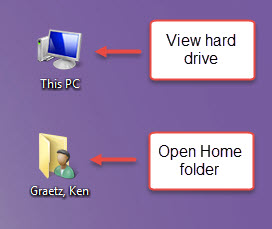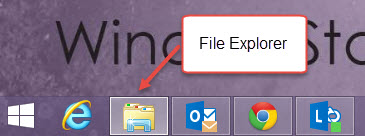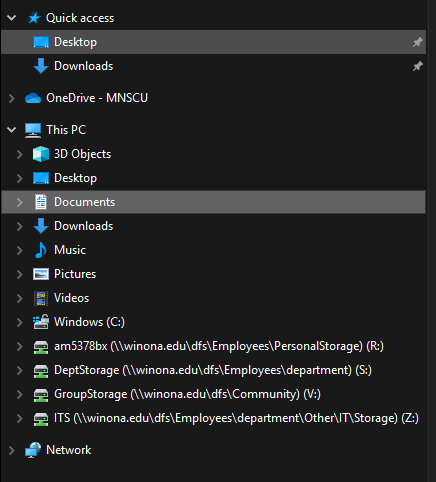Where on your PC laptop are your files
About this article
This article defines the default file folder locations of all WSU-supported PC laptops. It is intended for all students and employees who participate in the eWarrior Digital Life and Learning Program. It is important for everyone to know where their files are at all times, especially when preparing for a laptop exchange or re-image.
Where are your files?
You have full administrative rights to your laptop. That means you have the ability to save your files just about anywhere on your laptop's hard drive. You may have saved things, intentionally or unintentionally, to locations other than the ones described in this article. It's up to you to find and manage those folders and files. ITS configures every WSU EliteBook hard drive the same way:
- All EliteBooks have an icon on the Desktop that provides access to the hard drive. The icon is called This PC (Fig 1). Double-click this icon to open it. You can also open up the same view of the hard drive by selecting the File Explorer icon on the taskbar at the bottom of your screen (Fig 2).
- When you open your hard drive, you will see a list of locations on the left sidebar. The older laptops have things grouped under Libraries and This PC, but now we have Quick Access and This PC (Figure 3).
- There is also an icon on your desktop, marked with your name, that opens your Home folder (Fig 1).
About the Home folder
Your Home folder is a special folder on your hard drive set up just for you. This is where you should save any personal or school-related files on your laptop. To help you keep your files organized, WSU created some sub-folders in your Home folder (e.g., Documents, Music, Pictures). You can use these folders if you wish or you can create your own. You can also create sub-folders within these folders (e.g., a Courses folder inside your Documents folder). Build a folder structure that works for you.
How do I access the Home folder?
From the Desktop
- Double-click the folder icon on your desktop labeled with your name (Fig 1)
From the C: directory
- Double-click the This PC icon (Fig 1) or click on the File Explorer icon (Fig 2)
- From the left sidebar, select Boot/Programs (C:), Boot/Programs/Data (C:), or Windows (C:), depending on your EliteBook model
- Open the Users folder (Fig 4)
- Your home folder is the one with your StarID as the folder name
About the sub-folders in your Home folder
Documents, Music, Pictures, and Movies
These are folders that we created for you thinking that this might be a nice way for you to organize your files. If this works for you, great. If you want to create new folders with new names, that's fine too. However, keep in mind that these folders are default save locations for various applications. Even if you don't want to use them, please don't delete them for a while until you are sure you have your own folder structure and default save locations worked out.
Desktop
The Desktop folder in your Home directory contains all the folders, files, and shortcuts found out on your desktop. Some people like to store things, lots of things, right on their desktop. They save files, folders, and shortcuts to applications right out on the desktop. If this method works for you and you want to replicate it on another EliteBook or following a re-image, back up the Desktop folder and then copy and paste it to your Home directory on the new or re-imaged machine. Note that your shortcuts will not work on the new or re-imaged laptop if the applications they link to are not in the same place. The fastest way to restore them is to delete them and recreate them on the new laptop.
Downloads
This folder contains any application update, printer driver, or other software or hardware-related file you ever downloaded from the web. The vast majority of these files do not need to be retained because you will probably never use them again. However, this folder may also contain manuals, journal articles, image files, and other useful, downloaded documents or media that you do want to retain. Take a look through your Downloads folder regularly. Delete anything you don't need and move anything important to another folder to better organize it. Ideally, your Downloads folder should be empty.
Other sub-folders
There may be many other sub-folders in your Home folder. Some applications that you install on your laptop will create sub-folders in your Home folder to store personal data and files associated with that application. For example, installing TechSmith Camtasia creates a folder in your Home directory to store your project files. The actual application itself is stored in another location. For most applications, you can change their default save locations if you wish, but always check any sub-folders in your Home folder to see if there is anything in there you want to back up and retain.
Public folder
The Public folder is at the same level as your home folder (Fig 4). Because Windows is a multi-user operating system, the Public folder is there to allow you to store files that would be accessible to other people who log on to your EliteBook. Because no one but you typically logs on to your laptop, this folder isn't very useful. Don't delete it just in case you might need it someday.
What's a default save location?
Some applications have default save locations for files you create using that application. For example, Microsoft Word opens a specific folder in your Home directory the first time you Save a document and every time you select Save As. WSU has already set the default save location of many of the applications that came installed on your new laptop. For example, the default save location for Word is your Documents folder in your Home directory. When you install applications, the default save location is created automatically or you are asked to select one during the installation process. You want the default save location to be a folder in your Home directory. For example, when you install Apple iTunes, it will use your Music folder in your Home directory. Sometimes, an application will pick a very strange and out of the way default save location. Keep your eyes on this as you install applications and change the default save location if needed. Also, be careful about deleting or renaming existing folders in your Home directory if they are default save locations for an application.



